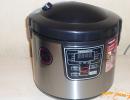How to Make Korean Carrots: A Quick, Spicy Snack
Korean carrots have long been a frequent guest in our diet. A quick snack and a ready-made ingredient for various salads, but it’s not always possible to choose it to your liking in a retail chain. Why not try making Korean food at home?
Cooking features
- You cannot use a grater - it crushes the fibers, which makes the taste different. If you don’t have one at home, it is recommended to cut the vegetable into thin strips by hand to make it the Korean way.
- After chopping, you need to prepare a “pillow” - place the orange strips in a bowl in a heap, in the center of which make a depression. All other ingredients are placed in this hole.
- Garlic is crushed immediately before being added, otherwise it loses its flavor.
- The resulting “Korean mass” must be placed tightly in a jar or pan, but in the latter case, pressure is needed.
- The process of infusing carrots in Korean, if vinegar is not used, first takes 12 hours at home at room conditions, then another 12 in the refrigerator. If the vinegar in the recipe doesn’t bother you, add it and put the container directly in the refrigerator.
About the ingredients

- You can prepare real carrots in Korean only from large, juicy and sweet root vegetables that do not have a light core.
- Sugar – it improves the taste, but it is not necessary to use it as a seasoning.
- It’s better to use cottonseed or corn oil if you want to cook it in Korean style, but when you don’t have that at home, regular deodorized oil will do.
- Essence works better instead of vinegar. Lemon juice can do the same.
- Monosodium glutamate is present in almost all store-bought seasonings. If you prepare a mixture of spices at home without it, the dish will be much healthier.
- Red pepper in this case is not only paprika, but also cayenne, chili, Tabasco. It is especially good to make a mixture.
Classic recipe

Ingredients:
- carrots – 1 kg;
- garlic – 1 whole head;
- rast. butter – 0.5 tbsp;
- vinegar - 6 tbsp. l.;
- onions for flavoring oil – 2 pcs.;
- red pepper and coriander - 1 tbsp each. l.;
- soy sauce – 1-2 tsp;
- sugar and salt - 1 tsp each;
- bay leaf, cloves, peppercorns.
Preparation:
- Grate the future Korean carrots.
- Add half of the specified amount of salt, knead it with your hands and leave it alone for half an hour so that it produces juice.
- Peel the garlic and chop it.
- Prepare a mound with a depression and put red pepper in it.
- You don’t need to chop the onion finely so that it’s easy to get out later. Flavor the oil and remove the onion. Do not use a wet spoon for this.
- Heat the oil very hot and pour it into a bowl.
- Add garlic and other spices, stir, let simmer for 10-15 minutes.
- Take a sample and adjust the taste if necessary.
- Place what you got tightly into a container and put it in the refrigerator for a day.
The rest of the Korean carrot recipes are based on this basic one. Only the housewife can decide how to cook it - what seasonings to use, what to add less of, and what should not be included in the list of ingredients.
Jewish salad with beans

Ingredients:
- Korean carrots – 250 g;
- cheese (preferably Parmesan) – 100 g;
- beans – 80 g;
- mayonnaise – 4 tbsp. l.;
- parsley, salt.
Preparation:
- Boil the beans. This will be done faster if you pre-soak it for several hours or a day.
- Grind the cheese on a coarse grater.
- Chop the parsley.
- Mix all ingredients, add salt, add mayonnaise, stir.
Chicken salad

Ingredients:
- Korean carrots – 200 g;
- hard cheese – 150-170 g;
- chicken fillet – 2 pcs.;
- tomato – 2 pcs.;
- bell pepper and cucumber – 1 pc.;
- green onions, mayonnaise.
Preparation:
- Boil the fillet and cut into strips.
- Prepare straws from pepper and cucumber.
- Peel the tomatoes and chop.
- Grind the cheese on a grater.
- Mix all ingredients with Korean carrots and chopped onions.
- Pour mayonnaise over and stir.

- Dry fresh carrots can be pre-placed in cold water.
- It is better to heat the oil in a frying pan or saucepan with a long handle so as not to get burned.
- Simmering the vegetable under a lid in a frying pan will help get rid of excess hardness.
- Is there dryness? Add more oil.
- It is permissible to have the marinade on hand at home, for which the necessary spices are poured into a jar and filled with hot oil.






